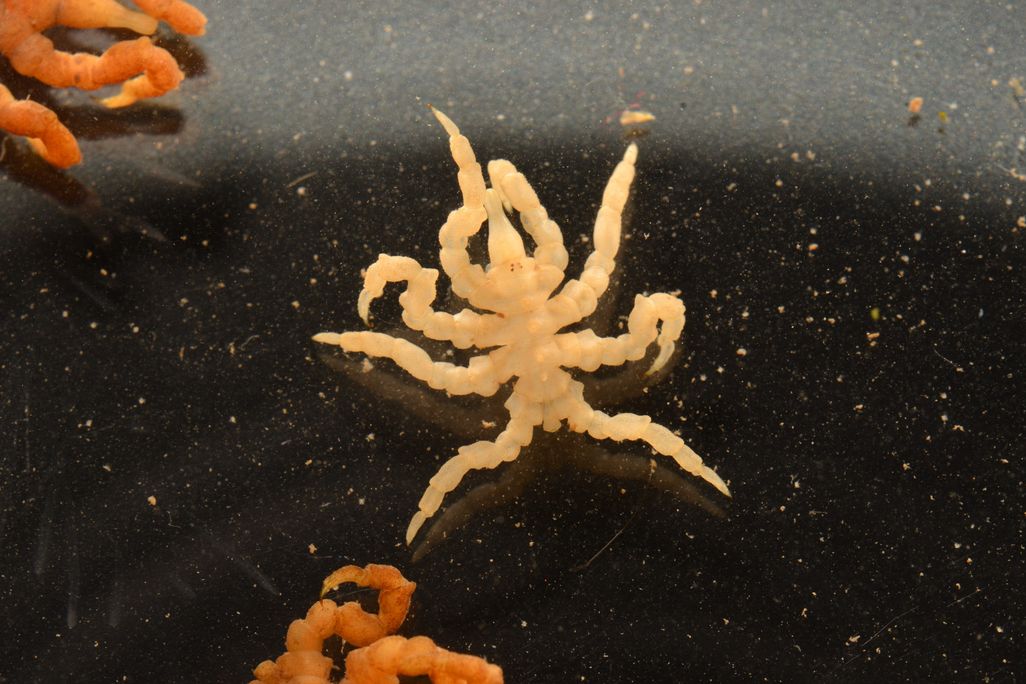
Researchers sequenced the knotty sea spider’s genome for the first time, revealing a missing gene that many other animals have

For the first time ever, the genome of a knotty sea spider was sequenced in high resolution.
Prashant Sharma / University of Wisconsin
Though sea spiders have thrived for millions of years in a variety of marine conditions—in cold Antarctic waters, on deep seafloors and along rocky, estuarine shorelines—it is correct to call them spineless and gutless.
That’s not an insult—it’s a biological description. The more than 1,300 known sea spider species are invertebrates, lacking a backbone. They belong to a group known as the chelicerates, which also includes land spiders, ticks and horseshoe crabs. And while these animals share similar claw-like mouths, the sea spiders stand out in one key way: They don’t have abdomens.
Fun fact: Sea spider feeding strategy
Many sea spider species have a vampire-like feeding technique—they puncture their prey with a long proboscis, then suck out its internal fluids.
Evolutionary biologists have long puzzled over sea spiders’ unique abdomen-less existence and the adaptations they’ve developed in its stead. Sea spiders keep their reproductive, digestive and respiratory organs inside their legs, which for some species can be less than an inch long, while those of others span nearly two feet across. They breathe through their skin, moving oxygen by contracting muscles, and some even eat methane with the help of bacteria.
Reproduction without much of a body is no less unique a process: Females eject their eggs from pores in their legs, then males combine them with sperm and attach the fertilized eggs to their legs in special sacs to wait for them to hatch.
“They’re weird,” Prashant Sharma, a biologist at the University of Wisconsin–Madison specializing in the genomics and development of ancient invertebrates, says in a statement. “Sea spiders are just incredibly cool and understudied animals. So, that’s what draws us to them.”
A sea spider belonging to the Colossendeis genus. These individuals are the largest sea spider species and are typically found in the deep sea. /https://tf-cmsv2-smithsonianmag-media.s3.amazonaws.com/filer_public/1d/7d/1d7d8121-c23a-4b9e-813a-52b03195567e/colossendeis_mnhn-iu-2013-2065.jpeg)
Sharma is a co-author of a study published this month in BMC Biology that sheds new light on sea spiders’ unusual evolutionary history. An international team of researchers collaborated to sequence the first chromosome-level genome of the knotty sea spider, Pycnogonum litorale, which comes from an early branch of the chelicerate family. The scientists hoped to better understand the genetics behind the species’ abdomen-free biology.
To do so, they turned to a laboratory population of sea spiders at the University of Vienna, which descend from several P. litorale adults that scientists collected in the rocky tidepools of the North Sea. At the lab, researchers fed and kept the creatures in wire cages until they reproduced. With the offspring, the team sequenced the species’ DNA and mapped the sea spiders’ 57 pseudochromosomes in high-resolution detail.
P. litorale, also known as the knotty sea spider, is endemic to the Atlantic Ocean./https://tf-cmsv2-smithsonianmag-media.s3.amazonaws.com/filer_public/ed/de/edded116-90fa-48ff-8caa-719150561249/pycnogonum_littorale_ypm_iz_030249.jpeg)
The team’s genetic analysis focused on the Hox cluster: a family of genes found widely across the animal kingdom that fundamentally control an organism’s physical development. The New York Times’ Veronique Greenwood writes that destroying certain Hox genes in a fruit fly “can make it grow legs where its antennae should be.”
“In arthropods, Hox genes play a central role in the correct specification of the different body segments,” Andreas Wanninger, a co-author of the study and an evolutionary biologist at the University of Vienna, says in a statement. “Also in many other animal groups, they are essential ‘master controllers’ during body plan development.”
The scientists discovered that knotty sea spiders are missing a key Hox gene called abdominal-A, which, in most arthropods, “helps establish the rear-body segments that carry guts and reproductive organs,” writes Andrei Ionescu for Earth.com.
A large sea spider, photographed in 2018 at a depth of roughly 3,681 feet. NOAA Office of Ocean Exploration and Research via Flickr under CC BY-SA 2.0/https://tf-cmsv2-smithsonianmag-media.s3.amazonaws.com/filer_public/62/b8/62b81c7a-301f-4be5-a286-363c8e1cac01/40052881683_30e4506bee_o.jpg)
The team also found that the knotty sea spider has never undergone whole-genome duplication, a process that leaves an organism with a copy of every gene. More genes make mutations and innovation more likely, and new species typically derive from accumulated changes. This suggests the knotty sea spider is closer to the base of the entire chelicerate family tree—its relative genetic simplicity was likely shared by the common ancestor of the larger chelicerate family.
Curiously, because the fossil record shows that sea spiders did have abdomens tens of millions and hundreds of millions of years ago, it remains unknown just when and why that changed. Environmental conditions may have shifted at some point in time, making abdomens less advantageous. Or, Hox genes may have become damaged somewhere in the sea spider lineage, causing the body part to shrink and essentially disappear.
“We don’t know what caused what,” Antonis Rokas, an evolutionary biologist at Vanderbilt University who was not involved in the study, tells the New York Times.
The authors hope to continue to investigate how other developmental genes across other sea spider species may have appeared or disappeared throughout their life history, per Earth.com, potentially affecting their abdomens.
“We don’t know quite when that structure was lost. We know they started out looking more like modern arthropods,” Sharma says in a statement. “And then, at some point, they just went totally bizarre. So weird.”

/https://tf-cmsv2-smithsonianmag-media.s3.amazonaws.com/accounts/headshot/ChristianThorsberg_Headshot.png)







Join our affiliate community and maximize your profits—sign up now! https://shorturl.fm/YyN76